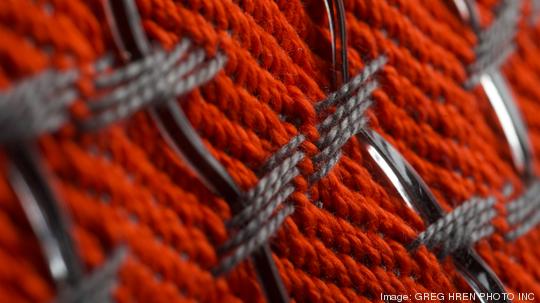
Imagine if you could call someone through a tiny speaker in your shirt, or if your jacket could pick up heart irregularities and notify your doctors. These are some of the not-so-far-off ideas being explored in a collaboration between MIT and the Rhode Island School of Design.
Researchers have created a new fabric that produces a signal when bent or mechanically deformed, also known as piezoelectric material. Researchers say this enables fabrics and textiles to convert sound vibrations into electrical signals, similar to how human ears hear.
According to the researchers, the new fabric can capture sounds ranging in decibel from a quiet library to heavy road traffic, and determine the precise direction of sudden sounds, such as handclaps. The material can also generate sound, which could be picked up by another similar fabric.
Wei Yan, who led development of the fiber as an MIT postdoc, tapped into a team of fellow researchers and academics at MIT, the Rhode Island School of Design, Case Western Reserve University, the University of Wisconsin at Madison and the U.S. Army Research Institute of Environmental Medicine in Natick, Mass.
Anais Missakian and Elizabeth Meiklejohn from RISD focused on the best way to use the new technology and integrate it with other textiles. Missakian, the Pevaroff-Cohn family endowed chair in textiles at RISD, said the collaboration grew from previous work on other projects with MIT, starting almost eight years ago.
“They’ve been working on this problem for a long time, but they didn’t have much knowledge about textiles and how best to work with it once it’s made,” Missakian said. “It’s about creating something technological while keeping the history and legacy of the textiles you’re using. We all want fabrics that have humanity, textiles we’re comfortable with.”
Researchers initially tested the fiber’s sensitivity to sound by attaching it to a suspended sheet of mylar and used a laser to measure its vibrations. That frequency was then played by a nearby speaker.
Beyond smart textiles
When it came time to pair the advanced fiber with textiles, the team experimented with several different iterations of the tech.
Meiklejohn is a RISD graduate student who wove some of the integrated fabric using a standard loom. The result, panels of drapable, machine-washable fabric, “feel almost like a lightweight jacket — lighter than denim, but heavier than a dress shirt,” Meiklejohn said in a statement.
Missakian said she’s been interested in the idea of smart textiles for decades but emphasized that this new tech is groundbreaking in that it aims to integrate the advanced fibers on a micro level.
“The work now continues as we look at new ways to collaborate and new applications,” she said. “There are product ideas, new collaborators like the health care field and hospitals and much more we can do to test out this new technology.”
The research was supported in part by the U.S. Army Research Office through the Institute for Soldier Nanotechnologies, National Science Foundation and Sea Grant NOAA.








